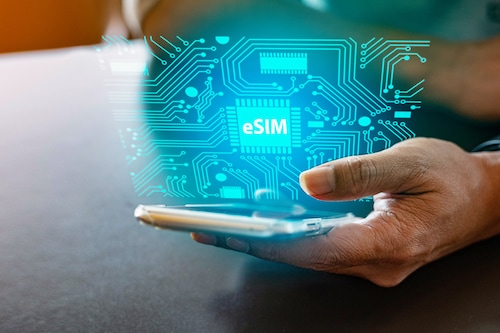After 5G, here comes the e-SIM
Besides offering the obvious feature of staying connected through a smart device without carrying a mobile phone, customers will find shifting to a new mobile number easier and faster through an e-SIM


The scramble for subscribers to move to 5G is on, in order to get a deeper, faster and more reliable (low latency) experience for users for their calls, data usage and connectivity. And even while subscribers are slowly starting to shift to a 5G network from 4G, the new buzzword is e-SIMs. All the three major telecom service providers—Reliance Jio, Bharti Airtel and Vodafone Idea—have, in recent weeks, launched their own e-SIMs.
E-SIMs are embedded SIMs already present on the motherboard of a cell phone device. It obviously means that your mobile phone needs to be SIM embedded. Some smart watches and newer models of smartphones are e-SIM enabled. For most others, the smart phone uses a physical SIM, in the form of a memory chips with a processor and a transmitter in it which would connect to the telecom tower to catch a signal.
India is still a predominant Android phone-led market. Around 85 percent of these use smartphones. Of this, 7-10 percent are estimated to be using Apple devices and the balance are Android.
One can move easily from a physical SIM to an e-SIM of the same telco provider. Also, there are some advantages of an e-SIM: If a user wants a new number and shift from Vodafone Idea to Bharti Airtel or Jio, say, they need to do the requisite KYC and just scan a QR code of the new telco. But if they want to retain the same number (port), they will need to go to the authorised showroom to get this done and request for this option.
The advantage of not carrying your mobile phone while exercising is a big advantage, if your e-SIM is connected to your smart watch. You also do away with the risk of losing or damaging a physical SIM card.
Simply because it is a new feature at this stage. As adoptability increases, the price of these e-SIM enabled smartphones is likely to drop.
Very much. As customers have slowly shifted from 2G/3G to 4G/5G networks in recent years, they will also start to accept e-SIMs. Technology analysts are confident that e-SIMs will pick up in India. Mobile phones have one less physical socket in their circuitry and will become a little more robust. Corporates are also more likely to adopt a e-SIM enabled device. As prices of these flagship e-SIM enabled phones drops, the adoptability will improve.
First Published: Nov 22, 2023, 11:06
Subscribe Now